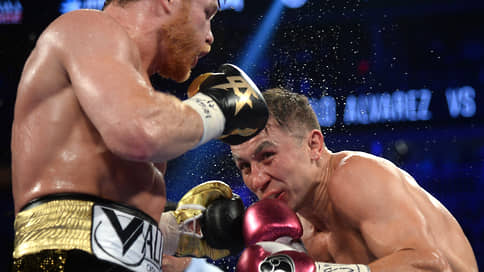Trilogical duel – Newspaper Kommersant No. 172 (7373) of 09/17/2022
[ad_1]

On Saturday in Las Vegas there will be a fight that not so long ago would have been perceived as an event with the brightest, blinding eye “sign”, because this is the third clash of the main geniuses of boxing, despite the fact that the previous two actually left more questions about whether who is more important than the answers. Now the brilliance has faded a little. And it would be more correct to talk simply about the third meeting of two chic boxers, one of whom, Kazakhstani Gennady Golovkin, is apparently already too old for great feats, and the other, Mexican Saul Alvarez, said goodbye to the image of a superman in May, losing to Dmitry Bivol.
Saturday’s fight at the T-Mobile Arena in Las Vegas is a gift for boxing, which, like any sports genre, loves closed, looped cool stories. And this story is both unusually cool and definitely needed an ending. Without this duel, she would have looked somehow inferior.
In the second half of the previous decade, Saul Alvarez and Gennady Golovkin were almost unanimously recognized as the main geniuses of modern boxing.
Both were wildly popular, both had colossal sects of admirers. And both competed in the same category – middleweight (up to 72.6 kg). So a clash in order to find out who was the main genius was inevitable. It happened, but, strictly speaking, it did not give a clear answer to the current question, which does not imply different interpretations, although, of course, Alvarez’s fans will not like this thesis. But here the nuances are important.
The first fight took place in 2017, and after it, little-known judge Adelaide Byrd gained fame thanks to the score on her card: after 12 rounds, she put 118:110 in favor of Alvarez. Byrd herself could not explain the origin of these figures after a seemingly absolutely equal duel. And it was thanks to them, these strange numbers, that the match turned out to be a draw.
The revenge was organized a year later, and before that, Saul Alvarez managed to serve a doping ban – a short one due to the softness with which it is customary in professional boxing to treat violators. This time it was almost a draw. It was recorded by one of the arbitrators, the other two gave the Mexican a win with a minimal margin, and dozens of experts questioned the fairness of the outcome.
The third fight seemed absolutely, or something, natural in this situation – both in the light of the non-obviousness of the results, and in the light of the commercial performance of the matches: they broke records in terms of revenue from ticket sales, and in total brought the organizers over $ 200 million. almost every year, either by announcing imminent negotiations between the teams of Alvarez and Golovkin, or by saying that they are already underway, and that everything is about to be decided. But in reality, the boxers each went their own way.
Alvarez put into practice bold plans to conquer the following categories, cementing the status of the king of boxing. Golovkin was reclaiming his top middleweight status by facing fighters of smaller caliber than the Mexican.
And finally, four years after the last battle of geniuses with the “trilogy”, it grew together, even if it turned out that it was easier to finish it not in the “native” middleweight for rivals, but in super middleweight (up to 76.2 kg): Alvarez belong all four championship belts – the World Boxing Council (WBC), the World Boxing Association (WBA), the International Boxing Federation (IBF) and the World Boxing Organization (WBO). But the problem is that the “billboard” of the fight, which, in theory, should drive everyone who appreciates good boxing crazy, has lost its luster in recent months. At least a significant part of it.
Gennady Golovkin turned 40 in April, and this is not even a veteran, but quite a critical age for a middleweight who needs more power, speed, age. And he performs in veteran mode: four fights since the offensive loss to Alvarez in 2018. And you can’t say about any of them that he looks like a top one, proving that the Kazakhstani is still not just a good, classy boxer, but an extraordinary boxer. For proof, opponents were needed at a level higher than Kamil Sheremeta or Ryota Murata.
Saul Alvarez, who is eight years younger than Golovkin, is still an athlete in his prime, but in May he also said goodbye to the image of a superman who can move mountains and outrun the wind. Alvarez for the second time in his life ventured into light heavyweight (up to 79.4 kg), but if with Sergey Kovalev in 2019 the Mexican copedthen another Russian Dmitry Bivol became for him an insurmountable barrier. And the style of Bivol’s victory, mixed primarily with superiority not in “physics”, but in tactical and technical flexibility and integrity, lowered him in the most authoritative ratings of the best boxers, regardless of the weight category, from the top line immediately beyond the top three.
And at the same time, without exception, all bookmakers, spitting on a peppery background, on a train of questions without clear answers left by the first two fights of Saul Alvarez and Gennady Golovkin, still accept bets on the victory of the Mexican who removed the crown with such odds, as if now he is fighting with completely ordinary character. And people who are well versed in boxing do not argue with them about whether there is intrigue in the third fight of two living legends or not. The Ring, for example, conducted a survey in front of him among 20 such professionals: former elite boxers, promoters, matchmakers, coaches, television analysts. Forecasts promising either easy or difficult success Alvarez got the same number after him – exactly two dozen.
[ad_2]
Source link









